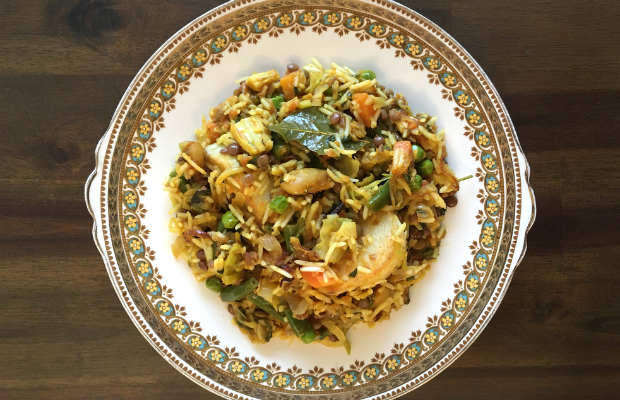In the interest of full disclosure, I must confess that prior to this project I had never cooked a biryani. The task seemed daunting. Back home in Durban, my dadima (grandmother) would spend a full day on her feet in the kitchen marinating meat, frying potatoes and soaking rice in preparation for a biryani dinner.
Growing up, I had only experienced one style of biryani: a layered biryani with meat at the bottom, then masoor (black lentils), followed by potatoes and rice. Only after steaming, the cook carefully mixed the meat and rice together, taking great care not to break up the soft, fluffy potatoes.
To begin my biryani journey, I consulted the holy grail of Indian cookery and the hallmark of a South African Indian kitchen: Indian Delights by Zuleikha Mayat. The 1970s cookbook features not one but seven different biryani recipes ranging from fish to pigeon to a Mughlai-style with sultanas and nuts. However, the most common recipe used in South African kitchens is simply titled “biryani” with instructions for chicken or lamb.
The rice
The star ingredient in any biryani is, of course, the rice. When cooked to perfection, biryani rice is aromatic and fluffy, with individual grains instead of clumps. Most recipes call for basmati, but for the sake of science, I made Indian Delights biryani with regular long-grain rice for comparison.
The rice is parboiled and layered with masoor in a flat-bottomed pot. Following my mother’s pro tip, I covered the top of the pot with foil before putting on the lid, to avoid any steam escaping. Cook at a high heat for five minutes until it starts sizzling, then lower the temperature and let simmer for an hour, at which time the moisture should have evaporated. Unfortunately, my dish did have excess moisture, so I quickly cooked it off on high heat, resulting in slightly overcooked rice.
By comparison, Naqiyah Mayat’s vegetable biryani in The Beginning calls for parboiled basmati rice, but the layered biryani is steamed in the oven at a low temperature. Naqiyah explains: “I suggest using the oven-steaming method if you are a novice cook. It is easier to monitor and achieves equally good results because the heat is distributed evenly, preventing the base layer from sticking.”
In her cookbook Spice Odyssey, Cariema Isaacs employs a completely different method of rice-cooking. The recipe entitled “Dutch Oven Chicken Dum Biryani” says it all: dum means to cook with steam.
Instead of parboiling the rice, Cariema cooks chicken and potatoes in a dutch oven before adding basmati and water. She cooks the dish on high heat for 15 minutes, switches off the stove, and lets the biryani steam for 45 minutes with the lid on.
Cariema’s biryani was by far the easiest to prep but, unfortunately, the most difficult to clean up: my mixture was scorched on the bottom, and during the high heat cooking, water began to bubble over the sides of the dutch oven.
As Naqiyah suggests, the easiest and most fool-proof method for novice biryani makers is oven-steaming. Her rice was perfectly cooked with individual grains, while the other two were slightly over-cooked.
Masoor and potatoes
Most biryani recipes layer meat or vegetables, masoor, potatoes, and then rice. Spice Odyssey seems to break all the rules by cooking potatoes with the meat, and skipping the masoor altogether.
Cariema specialises in Cape Malay cuisine but lives in Dubai, so her recipe perhaps draws inspiration from different countries and cultures. Cooking quartered potatoes in marinade intensely flavours the potatoes, but it breaks my family’s cardinal rule of biryani: you first have to fry the potatoes till golden to ensure they don’t break up when you serve.
While I grieved the lack of masoor in Cariema’s biryani, Zuleikha Mayat’s 50/50 ratio of rice and masoor seemed a bit out of balance.
After boiling the lentils, Naqiyah fries masoor in a teaspoon of ghee (clarified butter), which adds unnecessary richness in a dish that already involves generous amounts of oil, butter and ghee.
Spice and aromatics
Yoghurt is the magical ingredient that gently tenderises meat as it marinates overnight. Cariema’s blend of yoghurt, garlic, ginger, green chilli, turmeric, garam masala, cumin, coriander and tomato makes a particularly fragrant marinade, permeating the whole kitchen with a warm, comforting aroma.
While Naqiyah’s marinade is not as fragrant, it encompasses whole spices, which add a more pungent, earthy tone. Her exceedingly long list of spices includes whole cloves, star anise, bay leaves, cardamom pods, cinnamon sticks, curry leaves and fennel seeds, which provide a depth of flavour to otherwise-boring vegetables.
However, it’s the addition of fresh herbs that creates balance. Half a cup each of fresh mint and coriander helps to cut through the richness of biryani and create another dimension of flavour.
The most nerve-wracking (and miraculous) experience of every biryani recipe is securing the lid and walking away. To lock in steam and moisture, you’re not allowed to peek during the cooking process, but rather have faith that all is well.
Zuleikha Mayat perfectly sums up the reveal after a patient hour’s wait: “The pot of biryani, when finally opened, announced itself to the whole neighbourhood, and the aroma and fragrance that emanated was sufficient to make the most fastidious smack their lips in anticipation.”
Take a look at Nikita’s easy oven-steamed chicken biryani

